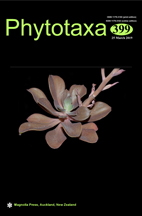Abstract
The nomenclatural notes, discussed in the present communication, are based on the revision of Iris Linnaeus (1753: 38) names described from Turkey, considering this genus in its wide sense (e.g., Dykes 1924, Mathew 1989, Güner 2012). Iris haussknechtii Bornm. ex Baker (1892: 4) is a species endemic to Turkey referred to I. ser. Spuriae (Diels 1930: 502) Lawrence (1953: 361) of I. sect. Limniris Tausch (1823: without pagination), treated at the generic level under the name Chamaeiris Medikus (1790: 417) (Crespo 2011, Crespo et al. 2015). It is a rhizomatous, perennial herbaceous, compact plant, with two terminal pale yellow or yellow and white flowers on single stem, the perianth segments with only yellow veins, and the narrow, rather tough leaves slightly shorter than flowers. According to some authors (Dykes 1912, 1924, Peckham 1939, Mathew 1984), it is a close relative to I. sintenisii Janka (1877: 244), except for the colour of the flowers, the shape of the outer perianth segments, the fact that the spathe valves are not sharply keeled (Dykes 1924), and the reported chromosome number: 2n = 18 in I. haussknechtii (Özkan et al. 2001, as “I. kerneriana”) vs 2n = 16 in I. sintenisii (Popova & Ceschmedjiev 1975). Based on herbarium specimens examination (deposited at E, K, and P; acronym according to Thiers 2019), we conclude that I. haussknechtii is distributed in the following northern Turkey provinces: Canakkale, Balikesir, Bolu, Kastamonu, Cankiri, Ankara, Corum, Sinop, Amasya, Tokat, Erzincan, as well as in Eskisehir, Afyonkarahisar, Kirikkale, Kirsehir, and Sivas (A. Güner, pers. comm.). This plant usually occurs in open sites, on stony soil amongst woodland, in dry meadows, scrubland, and on steep stony slopes at elevations ranging from 1150 to 2350 m (Mathew 1984). At the best of our knowledge, the name I. haussknechtii has not yet been typified. After the examination of all the original material and protologue, we designated the lectotype for this name.

